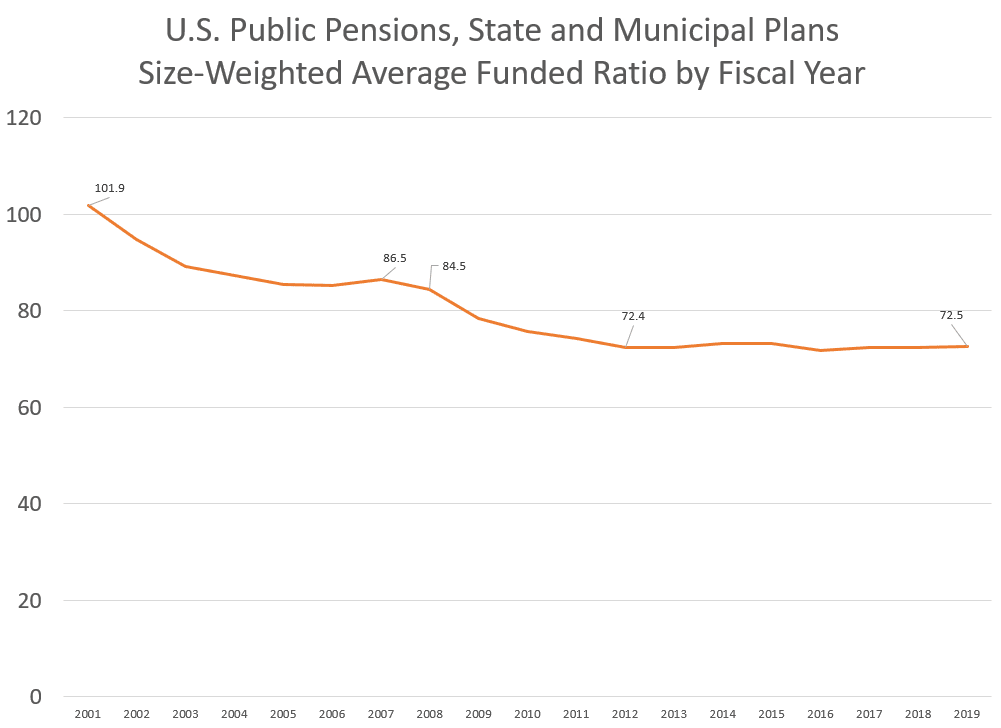Public Pensions Before the Storm
by meep
A re-post of a substack post of the same name
Since 2000, we’ve had two recessions, and likely are coming on another right now though this one is of a different nature than the prior two.
The 2001 recession actually was just a usual recession – a correction of the dot-com vaporware boom (it preceded the 9/11 terrorist attacks by months.) The 2008-2009 recession was deeper and broader, caused by a credit bubble within the residential real estate sector (and some other stuff). The current one, set off by a pandemic, is of quite a different nature, and how things will respond after increased mortality goes away is yet to be seen. However, we still have steep market drops… and that will absolutely affect the pension sector.
Public Pensions 2001-2019
In fiscal year 2001, many if not most public plans were officially 100% funded or better — the national size-weighted average was 102% funded, and a recession lasted from March to November 2001. By end of fiscal year 2008, which occurred for most public plans in mid-2008 before the market crash, the national weighted average was 84.5% funded. [all according to the Public Pensions Database]

Data source: Public Plans Database as of 22 March 2020
By FY 2019, that average was down to 74.5%, even though there had been a 10-year bull market. Heck, the funded ratio had been stagnating around this level since FY2012.
The overall 10-year time-weighted average return for FY2019 for U.S. public plans was 9.5% per year, well above investment return assumptions for pretty much all plans. And yet… a moribund funded ratio.

And yet, funded ratios dropped. Many aspects of public pension valuation and funding policies have led to eroding public pension fund strength even in good times: deliberately not making full payments to funds; assuming a growing amount of contributions in the future (that did not occur); siphoning off gains above-target returns with 13th checks or other pension benefit boosters.
And now we’re in bad times. Asset values have fallen, and may recover, but there is financial strain everywhere.
Classic STUMP: The fragility of can’t fail thinking
In 2014, I wrote a post on how “can’t fail” thinking has led to even more fragility in the public pensions system.
Back in May 2014, Calpers, the California public pension fund, filed an amicus brief in the Detroit bankruptcy. They made the following claim:
Calpers, which has been involved in disputes with the bankrupt city of San Bernardino, California, said the judge’s decision raises issues of critical importance to its 1.7 million members. If a municipality in bankruptcy is allowed to break state laws and ignore its obligations to the pension system, it “may threaten the actuarial soundness of the system as a whole,” Calpers said.
Here is what I had to say at the time (no, I will not “quote” myself).
What actually threatens the actuarial soundness of public pension plans is behavior like the following:
- Not making full contributions.
- Investing in insane assets so that you can try to reach target yield. Or even sane assets that have high volatility to try to get high return, forgetting that there are some low volatility liabilities that need to be met.
- Boosting benefits when the fund is flush, and always ratcheting benefits upward.
Calpers should be extremely familiar with that sort of behavior.
Here is the problem: all sorts of entities directly involved in public pensions have thought that the pensions can’t fail. Because of stuff like: constitutional protections of benefits (so paying pensions would take precedent over other spending needs, like paying for current services), “government doesn’t go out of business”, the supposedly infinite taxation power of the government, and so forth.
Because they thought that pensions could not fail in reality, that gave them incentives to do all sorts of things that actually made the pensions more likely to fail. Because, after all, the taxpayer could always be soaked to make up any losses from insane behavior.
Bailouts on deck?
That was back in 2014. And now we’ve seen extreme market volatility, the expectation of a global recession, and who knows what after.
There is current wrangling in the U.S. Congress over some sort of nationwide stimulus/bailout due to pandemic impacts, and the House bill seems to have some pension bailouts in it. Alas, it’s just embedding the Butch-Lewis Act to do a half-assed bailout of multiemployer pensions. The one where “loans” with no kind of strings attached are given to union pension plans. There’s also a bunch of other tenuously relevant Democratic wish-list items.
In looking at an MEP bailout, public pensions may look to themselves next in line.
Then there’s the aspect of the Federal Reserve buying municipal bonds:
The Federal Reserve said Friday [March 20] it would extend its asset purchase program into short-term municipal bonds.
….
However, continued disruption in the markets for state and local government debt promoted the Fed to take further action in its efforts to combat coronavirus effects. The market for munis this week has all but collapsed, with few willing to step in and buy the government debt in the uncertainty of the current climate.
In a statement, the Fed said the move is “to enhance the liquidity and functioning of crucial state and municipal money markets.”
With these two aspects of various money injections, I could see the public pension funds thinking: “Why not us?”
Good times wasted
But back to the original item: a decade of good market experience, and yet the public pension funded ratio never improved.
Since my old 2014 post, I’ve learned about other behavior public pensions engaged with, so that there was more than just insane asset behavior, shortchanging contributions according to official rules, and benefit boosting.
One of the main things I discovered was always assuming that more money would be contributed in the future — it wasn’t only the too-high discount rates used to value liabilities, but that payroll growth assumptions, as well as other experience assumptions, were always such that more would be paid later.

Then, I also found out many plans were throwing away their investment gains by giving retirees 13th checks, and similar ways of reducing assets when times are good. And yet… when times are bad…. you don’t see a symmetric reduction in benefits.
Hmmm.
Given that ten years of good market performance didn’t lead to any improvement in funding status makes one really wonder.
On the Public Plans Database national stats page, the data show that the assumed return on assets decreased from 7.65% in FY2012 down to 7.22% in FY2019. That’s a change of less than 50 basis points, and really isn’t the sole reason funded ratios did not improve. And, as remarked earlier, the 10-year experience was about 9.5%. Yes, the longer term averages were lower. Even so, one would have expected some improvement in financial status over a decade.
Reality always wins. Public plans had been expecting that an already fairly good financial environment would end up even better…

I will be looking at various aspects of public pensions and likely effects of the current financial fallout (and other fallout) from COVID-19.
But it helps to remember the status of the plans before crisis hit.
For many of the plans, they were in a worse place from the financial crisis of 2008-2009, and had been surrounded by policy such that they never improved.
People need to think about a more sustainable framework for public employee retirement, because the current standard model is set up for fragility.
